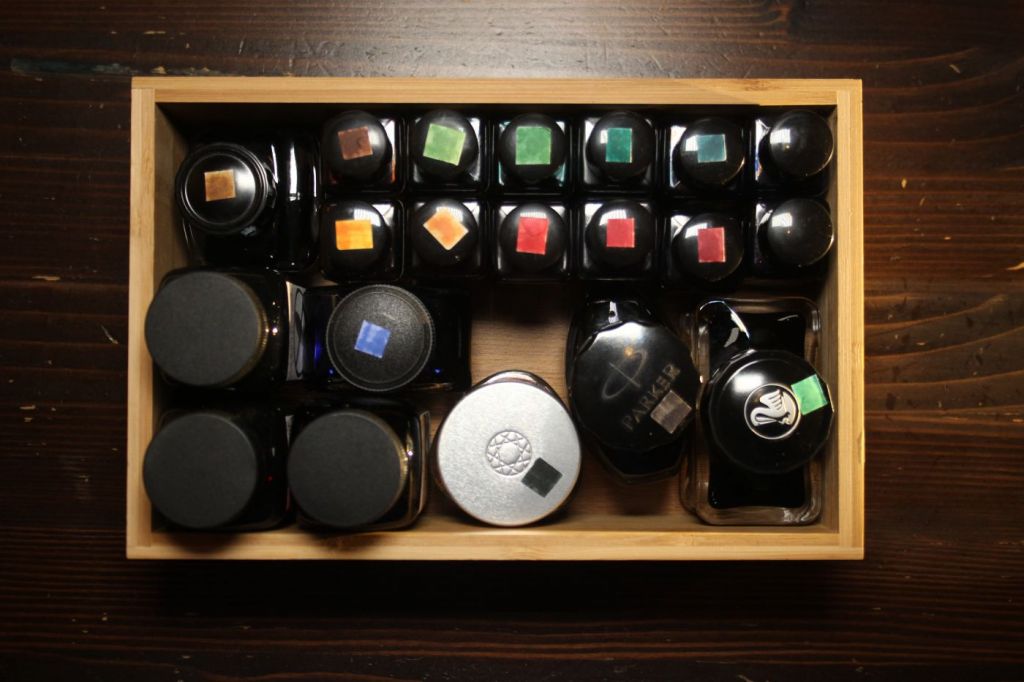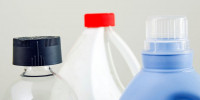How to Store Fountain Pen Ink Bottles (Make It Last)

Fountain pen ink can last you a long time if you store it correctly. There's not much to it if you understand the fundamentals, which I'll explain in this article.
How to store fountain pen ink? Fountain pen ink should be stored in airtight bottles, preferably glass. Keep the bottles in a dark, dry, and cool place; a dedicated drawer, for example. If you plan on storing the ink long term, consider keeping the bottles in their original cardboard boxes, and sealing them in an airtight container.
There is something to be said to be an ink storage purist and maximize shelf life. However, I think you can overdo it. Read on to find out how to store effectively yet stay sane.
In this article:
How To Make Sure Your Ink Lasts
Storing your ink could be an elaborate system or just a quick and simple fix that relies on fundamentals. Here are the best practices all fountain pen enthusiasts agree on:
- Make sure the caps are on tight
- Use glass bottles as much as possible
- Keep out of UV light
- Use your bottles hygienically
If you do those four things in one form or another, most of your ink will probably last you a long time. However, there will always be bad apples that want to rot. Sometimes, a bad batch ships out, or the manufacturer got the recipe wrong. This is especially the case for inks with special attributes. But most regular ink colors by premium brands will remain stable for a long time if stored properly and used correctly.
To be fair, ink is not necessarily meant to collect (although you'd suspect otherwise with the amounts of limited edition series coming out nowadays—savvy marketers). It is mostly meant to use: it is a consumable. Whether it will remain stable for decades is for us to find out. But doing most or all of the above tips will absolutely help the ink survive.
To be perfectly clear, I use my ink pretty irresponsibly. I put back used ink (if my pen is reasonably clean) and store my bottles out in the open. I just like to look at them. Well, knowing it and living it are two different things, as they say. But until now, I haven't had ink-opolypse, so, after half a decade of fooling around, I'd call that a success.
Ink cartridges
All of this goes for ink cartridges as well. However, they probably won't last you decades without a little hack. Since they are stored inside plastic containers, they will most likely evaporate. To store them long term, I recommend putting them in airtight ziplock bags.
Keep out of UV light
UV light will change the color of your ink over time. Mostly, we mean direct sunlight by UV light. While it is changing your ink, it will heat it up as well, which could alter it in other ways I don't really understand, but it's bad. Please note that artificial lighting contains some UV light as well. Store your ink in the original cardboard boxes if possible, or dedicate a drawer to your bottles.
In short: the deeper inside your house you tuck them away, the better. Since you actually need to get to the ink bottles pretty regularly, it's not always practical to seal them off hermetically.
Here's a tip: keep your most-used bottles at hand. Tuck the rest away. Any ink you use a lot won't last you more than a couple of years anyway. Most ink can be stored on top of your desk and stay good for 2-3 years without problems.
Use glass instead of plastic bottles
Glass is probably the best material to store your ink in. Plastic is porous, while glass is not. Whenever ink is stored in plastic, its water content will slowly evaporate, leaving only the dyes behind. You can recognize evaporated ink by dry pigment. In some cases, you can dilute dried ink by adding some water; however, old ink might clog up your feed, so it's at your own risk.
Use your bottles hygienically
Most inks that go bad do so because of contamination. The easiest way to contaminate your ink is by putting in your dirty pen when filling straight from the bottle. You have put your fingers all over the pen's section for about a month, which now contains a month-wide spectrum of finger bacteria, which it'll happily share with your virgin ink. Quickly disinfecting your pen before filling should fix this problem. I never do this, but I probably should now that I read this back (it sounds disgusting).
You also want to flush out your feed by simply pulling and pushing some tap water (or distilled water for the purists) through the feed. I use my converter for this, but you could also get a bulb syringe. After that, you're good to dip that pen deep inside the ink well.
Reasons Ink Goes Bad
In the fountain pen community, we use the acronym STIB for bad ink: Shit in the Bottle. I think that's an appropriate acronym, all things considered. You get shit in the bottle through contamination.
The most common shit you get in the bottle are slime and mold. If your ink looks slimy, ditch it. If it has a bad smell, you should also get rid of it. Dry ink can be diluted in some cases, but I personally wouldn't risk it.
If you want to learn more about ink's shelf life, read the article here.
How Long Do You Want to Store Your Inks?
At this point in the article, I want to take a step back to reflect on what we actually want to achieve here. I think it's important to separate the purists from most people. I was simply wondering: 'how do I store my ink in a way that it doesn't go bad before I finish the bottle?' It is perfectly clear to me now that I do a lot of things wrong, according to the purist. Luckily, my ink has the final say, and it hasn't complained yet.
So let's distinguish two widely different storing goals:
- Ultimate storage solution, allowing you to hand over your entire collection to your children or grandchildren.
- Regular storage, ensuring you will be able to keep using the ink normally.
I'll call the first one 'Inter-Generational Storage'—yes, I like the sound of that. Let's call the second 'Regular Storage'. For most people, like me, regular storage will do.
Regular Storage
Keep your ink in a drawer at a reasonably cool place (not above your gaming PC cooling fan) or a place that has a pretty stable temperature at least. Keep it in the original bottles. Quickly clean and flush out your pen before refilling it from the bottle. Close the caps tightly when you are done using the bottle.
I think in most cases this will do fine as far as ink storage, and there's no further need to freak out about your ink habits - unless you're a purist, which is fine too. Read on for something that's closer to your heart.
Inter-Generational Storage
If you want to keep your ink for decades, you'll have to keep more in mind than just the storage location. The packaging is just as important, and also your ink hygiene. To improve the chances of keeping your ink stable for multiple decades, I recommend taking a couple of extra precautions:
- only use glass bottles
- don't open ink bottles you plan on storing long-term; keep them sealed
- keep your ink in the original cardboard box
- place your bottles in an airtight container
- don't fill your pen directly inside the bottle; transfer some ink to a plastic cup using a disinfected syringe
- avoid European inks
Packaging
Plastic is porous, which will speed up evaporation. You can also get glass bottles and pour over your inks with plastic bottles.
With glass bottles, you still have plastic caps. If you want to make absolutely sure your ink doesn't evaporate, simply add another layer of defense by putting them in an airtight container. This might be a bit much for most people, which is why I mention it here and not under regular storage.
Avoid European inks
This is mostly a hunch I have based on something I read a couple of days ago.
Ink consists of five main parts: water; dyes; lubricants; surfactants (to bind the ink together); and biocides (to kill bacteria).
If the biocide content is low or out of whack, your ink will eventually contaminate and have bacteria growth. Nowadays, ink mostly uses less aggressive biocides (might be called passive-aggressive biocides, IDK), due to stricter regulations to protect the environment and yourself. While there are a lot of 20th-century inks around that can still be used, we don't know whether our contemporary ink will survive as well. The regulations are strictest in the EU (that's a first), so my guess is that those inks will spoil first.
How to Use your Bottles Hygienically
If you really want to nail your ink hygiene, you should avoid filling from the bottle directly altogether. You do need a syringe with a blunt needle in order to make this work.
- Disinfect your needles before use
- Use your syringe to suck up roughly 1ml of ink
- Close the ink bottle as fast as possible
- Put the ink straight into the converter
- Prime the nib
- Clean your syringe
Full disclaimer: I really don't use this elaborate process myself; I like to use my pens fast and dynamically — if that costs me a bottle of ink every five years, I'm fine with it.
Ultimate Ink Storage: What You Need to Do
To summarize, here's what you'll need to do to get the maximum shelf life out of your ink bottles. In order to be able to use your ink for a long time:
- you want to minimize the possibility of contamination by using your bottles hygienically
- you want to minimize evaporation by using glass bottles
- you want to minimize evaporation by sealing off your bottles in airtight containers
- you want to minimize desaturation by keeping your bottles out of direct sunlight or other UV sources
- you want to minimize temperature swings as much as possible
I think that most ink will last you just about as long as you'll need it to, as long as you keep them tightly capped and out of direct sunlight.
Did you find the answer to your specific question?
👍 25 👎 1


Comments
Choi
Your writing helped me a lot.
I got about 200 bottles of ink in about a year.
I put it in the drawer as new, but I was still nervous and looked for information.. And your writing reassured me.(of course I’m still anxious a little…)
I really hope that my ink will last 50 years. I will try to keep the ink well in the future. Thank you
Oh, and If you have any new tips on ink storage, let me know. I don’t want to spoil my beautiful colored inks.
-Choi .with google translator
Sarah
Thank you so much for putting this all together. It’s so incredibly helpful!
I was surprised how much of it I’m thankfully already naturally getting right just from years of being a nerdy collector of figurines and related collectibles, that need to be kept in their boxes, away from sunlight and humidity etc.
I also have the odd advantage with my health situation where I’m predominantly bedridden and spend my life in this one room which is air conditioned, something I have to help reduce my seizures, migraines, asthma issues and more, but that brings the bonus of offering perfect stable temp control in my room. Also, due to severe light sensitivity I also have black out curtains and use relatively low lighting, just via a clip on LED lamp on bed and LED smart bulb in my desk lamp that I control via an app. So even the few inks I do have out on display on my desk by my bed get very little light exposure.
Though I am now considering getting a wooden box to pop them all in to stop it completely.
my
Sarah
Thank you for putting this together. It’s incredibly helpful!
I was surprised how much of it I’m thankfully already getting right just from years of being a nerdy collector of figurines and related collectibles that need to be kept in their boxes, away from sunlight and humidity etc.
I also have the odd advantage with my health situation where I’m mostly bedridden so spend my life in this one air conditioned room. I have it to help reduce seizures, migraines, asthma issues & more, but that brings the bonus of perfect stable temp control in my room.
Also, due to light sensitivity I also have black out curtains and use low lighting, just a clip on LED lamp on my bed and LED smart bulb in my desk lamp. So even the few inks I have out on display on my desk get very little light exposure. But I will get a box to pop them in now.
I’ve also inked up with a syringe for a long time, just not disinfected it. Ooops! Another new step! But it won’t work with my vintage pens where I can only clean the pen itself.
Leave a comment